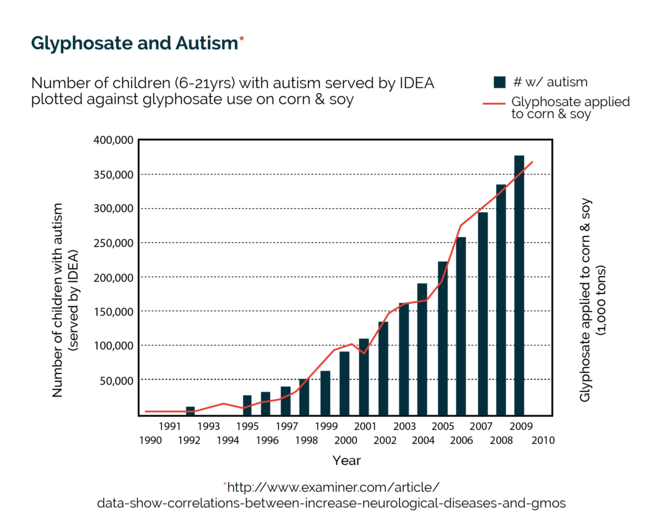The Importance of Testing for Glyphosate: The World’s Most Widely Used Herbicide
William Shaw, PhD & Matthew Pratt-Hyatt PhD
Director and Associate Director of The Great Plains Laboratory Inc.

PUBLISHED IN THE JANUARY 2017 ISSUE OF TOWNSEND LETTER
Glyphosate is the world’s most widely produced herbicide and is the primary toxic chemical in Roundup™, as well as in many other herbicides. In addition, it is a broad-spectrum herbicide that is used in more than 700 different products from agriculture and forestry to home use. Glyphosate was introduced in the 1970s to kill weeds by targeting the enzymes that produce the amino acids tyrosine, tryptophan, and phenylalanine. This pathway (called the Shikimate Pathway) is also how bacteria, algae, and fungi produce the same amino acids. This pathway is not present in humans, so manufacturers of glyphosate claim this compound is “non-toxic” to humans. However, evidence shows there are indeed human consequences to the widespread use of this product when we consume plants that have been treated with it and animals who’ve also consumed food treated with it.
Usage of glyphosate amplified after the introduction of genetically modified (GMO) glyphosate-resistant crops that can grow well in the presence of this chemical in soil. In addition, toxicity of the surfactant commonly mixed with glyphosate, polyoxyethyleneamine (POEA), is greater than the toxicity of glyphosate alone.1 In 2014, Enlist Duo™, a herbicide product which contains a 2,4-dichlorophenoxyacetic acid (2,4- D) salt and glyphosate, was approved in Canada and the US for use on genetically modified soybeans and genetically modified maize, both of which were modified to be resistant to both 2,4-D and glyphosate. 2,4-D, which has many known toxic effects of its own is perhaps better known as a component of Agent Orange, an herbicide used by the United States during the Vietnam War to increase aerial visibility from war planes by destroying plant growth and crops.


Glyphosate and Chronic Health Conditions
Recent studies have discovered glyphosate exposure to be a cause of many chronic health problems. One specific scientific paper listed Roundup™ as one of the most toxic herbicides or insecticides tested.2 Exposure to glyphosate has been linked to autism, Alzheimer’s, anxiety, cancer, depression, fatigue, gluten sensitivity, inflammation, and Parkinson’s.3-4 A 54-year-old man who accidentally sprayed himself with glyphosate developed disseminated skin lesions six hours after the accident.6 One month later, he developed a symmetrical parkinsonian syndrome.
Figure 1 shows the correlation between glyphosate usage and rates of autism, tracking services received by autistic children under the Individuals with Disabilities Education Act (IDEA). This data was originally collected by Dr. Nancy Swanson, along with similar data for many other chronic disorders.14 The causes for these disorders have been linked to glyphosate’s impact on gut bacteria, metal chelation, and P450 inactivation.5-6 It can enter the body by direct absorption through the skin, by eating foods treated with glyphosate, or by drinking water contaminated with glyphosate.
A recent study stated that a coherent body of evidence indicates that glyphosate could be toxic below the regulatory lowest observed adverse effect level for chronic toxic effects, and that it has teratogenic, tumorigenic and hepatorenal effects that can be explained by endocrine disruption and oxidative stress, causing metabolic alterations, depending on dose and exposure time.7
Glyphosate, Cancer, and the Microbiome
The World Health Organization International Agency for Research on Cancer published a summary in March 2015 that classified glyphosate as a probable carcinogen in humans.8 Possible cancers linked to glyphosate exposure include non- Hodgkin lymphoma, renal tubule carcinoma, pancreatic islet-cell adenoma, and skin tumors. Studies have also indicated that glyphosate disrupts the microbiome in the intestine, causing a decrease in the ratio of beneficial to harmful bacteria.9 Thus, highly pathogenic bacteria such as Salmonella entritidis, Salmonella gallinarum, Salmonella typhimurium, Clostridium perfringens, and Clostridium botulinum are highly resistant to glyphosate, but most beneficial bacteria such as Enterococcus faecalis, Enterococcus faecium, Bacillus badius, Bifidobacterium adolescentis, and Lactobacillus spp. were found to be moderately to highly susceptible.
The relationship between the microbiome of the intestine and overall human health is still unclear, but current research indicates that disruption of the microbiome could cause diseases such as metabolic disorder, diabetes, depression, autism, cardiovascular disease, and autoimmune disease.
Glyphosate and Chelation
Another study found that glyphosate accumulated in bones. Considering the strong chelating ability of glyphosate for calcium, accumulation in bones is not surprising. Other results showed that glyphosate is detectable in intestine, liver, muscle, spleen and kidney tissue.5 The chelating ability of glyphosate also extends to toxic metals.10 The high incidence of kidney disease of unknown etiology (renal tubular nephropathy) has reached epidemic proportions among young male farm workers in sub-regions of the Pacific coasts of the Central American countries of El Salvador, Nicaragua, Costa Rica, India, and Sri Lanka.11
The researchers propose that glyphosate forms stable chelates with a variety of toxic metals that are then ingested in the food and water or, in the case of rice paddy workers, may be absorbed through the skin. These glyphosate-heavy metal chelates reach the kidney where the toxic metals damage the kidney. These authors also propose that these chelates accumulate in hard water and clay soils and persist for years, compared to much shorter periods of persistence for non-chelated glyphosate. Furthermore, these chelates may not be detected by common analytical chemistry methods that only detect free glyphosate, thus dramatically reducing estimates of glyphosate persistence in the environment when metals are high (for example, in clay soil or hard water).
Testing for Glyphosate
Because glyphosate has been linked with many chronic health conditions, testing for glyphosate exposure and particularly the level of exposure is important. The lower limit of quantification (LLOQ) for The Great Plains Laboratory’s Glyphosate Test is 0.38 ?g/g of creatinine. The Great Plains Laboratory is the only CLIA certified lab currently performing a test for glyphosate in urine. Our Glyphosate Test can be performed on the same urine sample as for some of our other comprehensive tests, including the Organic Acid Test (OAT) or GPL-TOX (Toxic Non-Metal Chemical Profile). See Figure 2 for an example of our Glyphosate Test report.
As previously mentioned, glyphosate works by inhibiting the synthesis of tryptophan, phenylalanine, and tyrosine in plants. Humans need to obtain these amino acids from food sources. When food sources have scarce amounts of these amino acids due to glyphosate use, humans are at risk for deficiency too. Humans also require bacteria to maintain a healthy immune system. Research indicates that glyphosate decreases the amount of good bacteria in the gut such as bifidobacteria and lactobacilli and allows for the overgrowth of harmful bacteria such as campylobacter and C. difficile.12 Our lab has observed this in patients. We had a female patient who was suffering from depression who did a Glyphosate Test and an Organic Acids Test. Her glyphosate results were 2.99, which was over the 95th percentile and can be seen in Figure 3.
Upon analyzing her OAT we noticed two things. The first was that her 4-cresol was extremely high. This increased 4-cresol can be seen in Figure 4. As stated earlier, glyphosate exposure decreases the good bacteria and allows C. difficile to invade. C. difficile produces a toxin called 4-cresol, which we measure in the OAT. Research has shown that 4-cresol inhibits dopamine beta-hydroxylase.13 Dopamine beta-hydroxylase converts dopamine to norepinephrine. In the OAT we measure both homovanillic acid (dopamine metabolite) and vanillylmandelic acid (norepinephrine metabolite). We have observed patients with a high 4-cresol value have elevated homovanillic acid, which indicates an inability to convert dopamine to norepinephrine. The results from our aforementioned patient were consistent with these other results and can be seen in Figure 5. The recommendations for this patient were to treat her glyphosate exposure and to treat her C. difficile infection.
The results from these tests are indicative of why using the Organic Acids Test and Glyphosate Test together is so valuable and can help you provide more focused treatment for your patients. Treatment of glyphosate toxicity should be centered on determining the route of introduction and avoiding future exposure. Eating organic, non-GMO (genetically modified organism) foods and drinking reverse osmosis water are two of the best ways to avoid glyphosate.
A recent study showed that people eating organic food had considerably lower concentrations of glyphosate in the urine.7 Drinking extra water may also be beneficial since glyphosate is water soluble, but that water should be filtered to remove pesticides or, ideally, be treated by reverse osmosis. More than 90% of corn and soy used are now of the GMO type. In addition, non-GMO wheat is commonly treated with glyphosate as a drying procedure. Glyphosate is somewhat volatile and a high percentage of rain samples also contained glyphosate.7
Figure 2

Figure 3

Figure 4

Firgure 5

Summary
High correlations exist between glyphosate usage and numerous chronic illnesses, including autism. 14 Other disease incidences with high correlations include hypertension, stroke, diabetes, obesity, lipoprotein metabolism disorder, Alzheimer’s, senile dementia, Parkinson’s, multiple sclerosis, inflammatory bowel disease, intestinal infections, end stage renal disease, acute kidney failure, cancers of the thyroid, liver, bladder, pancreas, kidney, and myeloid leukemiaThe Perfect add-on test to the GPL-Tox.
Dr Shaw is board certified in the fields of clinical chemistry and toxicology by the American Board of Clinical Chemistry. Before he founded the Great Plains Laboratory Inc., Dr. Shaw worked for the Centers for Disease Control and Prevention (CDC), Children’s Mercy Hospital, University of Missouri at Kansas City School of Medicine, and Smith Kline Laboratories. He is the author of Biological Treatments for Autism and PDD, originally published in 1998, and Autism: Beyond the Basics, published in 2009. He is also a frequent speaker at conferences worldwide. He is the stepfather of a child with autism and has helped thousands of patients and medical practitioners to successfully improve the lives of people with autism, AD(H)D, Alzheimer’s disease, arthritis, bipolar disorder, chronic fatigue, depression, fibromyalgia, immune deficiencies, multiple sclerosis, OCD, Parkinson’s disease, seizure disorders, tic disorders, Tourette syndrome, and other serious conditions.
William Shaw, PhD
Dr Pratt-Hyatt received his PhD in cellular and molecular biology from the University of Michigan. He has trained under Dr. Paul Hollenberg, a prominent researcher on drug metabolism, and Dr. Curtis Klaassen, one of the world’s leading toxicologists. He has over a dozen publications in well-known research journals such as the PNAS and Cell Metabolism. He is currently associate laboratory director at the Great Plains Laboratory Inc. in Lenexa, Kansas, focused on diagnosis and treatment of mitochondrial disorders, neurological diseases, chronic immune diseases, and more. He specializes in developing tools that examine factors at the interface between genetics and toxicology. His work is bringing new insight into how genes and toxicants interact and how that may lead to mental health disorders, chronic health issues, and metabolism disorders.
Matthew Pratt-Hyatt, PhD
- Bradberry SM, Proudfoot AT, Vale JA. Glyphosate poisoning. Toxicol Rev. 2004;23(3):159-67.
- Mesnage R et al. Major pesticides are more toxic to human cells than their declared active principles. Biomed Res Int. 2014: 179691
- Samsel A, Seneff S. Glyphosate, pathways to modern diseases II: Celiac sprue and gluten intolerance. Interdiscip Toxicol. 2013;6:159-184.
- Samsel A, Seneff S. Glyphosate, pathways to modern diseases III: Manganese, neurological diseases, and associated pathologies. Surg Neurol Int. 2015; 6: 45.
- Krüger M, Schledorn P, Schrödl W, Hoppe HW, Lutz W, Shehata AA. Detection of Glyphosate Residues in Animals and Humans. J Environ Anal Toxicol. 2014. 4:2 http://dx.doi.org/10.4172/2161- 0525.1000210
- Barbosa ER, Leiros da Costa MD, Bacheschi LA, Scaff M, Leite CC. Parkinsonism after glycine-derivative exposure. Mov Disord. 2001. 16: 565-568.
- Mesnage R, Defarge N, Spiroux de Vendômois J, Séralini GE. Potential toxic effects of glyphosate and its commercial formulations below regulatory limits. Food Chem Toxicol. 2015 Oct;84:133-53.
- Guyton KZ, Loomis D, Grosse Y et al. Carcinogenicity of tetrachlorvinphos, parathion, malathion, diazinon, and glyphosate. Lancet Oncol. 2015 May;16(5):490-1
- Shehata AA, Schrödl W, Aldin AA, Hafez HM, Krüger M. The effect of glyphosate on potential pathogens and beneficial members of poultry microbiota in vitro. Curr Microbiol. 2013 Apr;66(4):350-8.
- Jayasumana C, Gunatilake S, Siribaddana S. Simultaneous exposure to multiple heavy metals and glyphosate may contribute to Sri Lankan agricultural nephropathy. BMC Nephrology 2015;16:103. doi 10.1186/s12882-015-0109-2
- Jayasumana C, Gunatilake S, Senanayake P. Glyphosate, hard water and nephrotoxic metals: Are they the culprits behind the epidemic of chronic kidney disease of unknown etiology in Sri Lanka? Int. J. Environ. Res. Public Health 2014;11:2125-2147.
- Clair E et al. Effects of Roundup® and glyphosate on three food microorganisms: Geotrichum candidum, Lactococcus lactis subsp. cremoris and Lactobacillus delbrueckii subsp. bulgaricus. Curr Microbiol. 2012;64: 486-491.
- DeWolf WE Jr. Inactivation of dopamine beta-hydroxylase by p-cresol: isolation and characterization of covalently modified active site peptides. Biochemistry. 1988;27: 9093-9101.
- Swanson NL, Leu A, Abrahamson J, and Wallet B. Genetically engineered crops, glyphosate and the deterioration of health in the United States of America. Journal of Organic Systems. 2014; 9(2):6- 37.
- Environmental Protection Agency. Pesticides Industry Sales & Usage. 2006 and 2007 Market Estimates. Available at https://www.epa.gov/sites/production/files/2015-10/documents/market_ estimates2007.pdf. Accessed July 15, 2015.
- Shehata AA et al. The effect of glyphosate on potential pathogens and beneficial members of poultry microbiota in vitro. Curr. Microbiol. 2013;66: 350-358.
- Larsen K et al. Effects of sublethal exposure to a glyphosate-based herbicide formulation on metabolic activities of different xenobiotic-metabolizing enzymes in rats. Int J Toxicol. 2014;33: 307-318.
Share:
Related Posts

Healthy Coffee Alternatives: When to Quit Coffee & What to Drink Instead
Dr Thomas Wnorowski February 16, 2024 Key Points: Does the idea of quitting coffee make you feel all sorts of (terrible) things? It’s common. But

How Your Social Network Impacts Your Mental Health
Austin Ruff April 17, 2024 Humans are inherently social creatures. It’s in our nature to connect and want to be connected to the people around

Microbiota-Gut-Brain Axis: Behaviour and Dementia Implications
People take supplements to improve or optimize their health. So what happens when you look at the label, and the ingredient list is filled with

Gut Bacteria and GABA
People take supplements to improve or optimize their health. So what happens when you look at the label, and the ingredient list is filled with

Unlocking the Power of Phospholipids
Jessica Kane Berman with Nat Niddum Phospholipids provide the building blocks for cell membranes which support healthy brain function. The value of these in longevity

